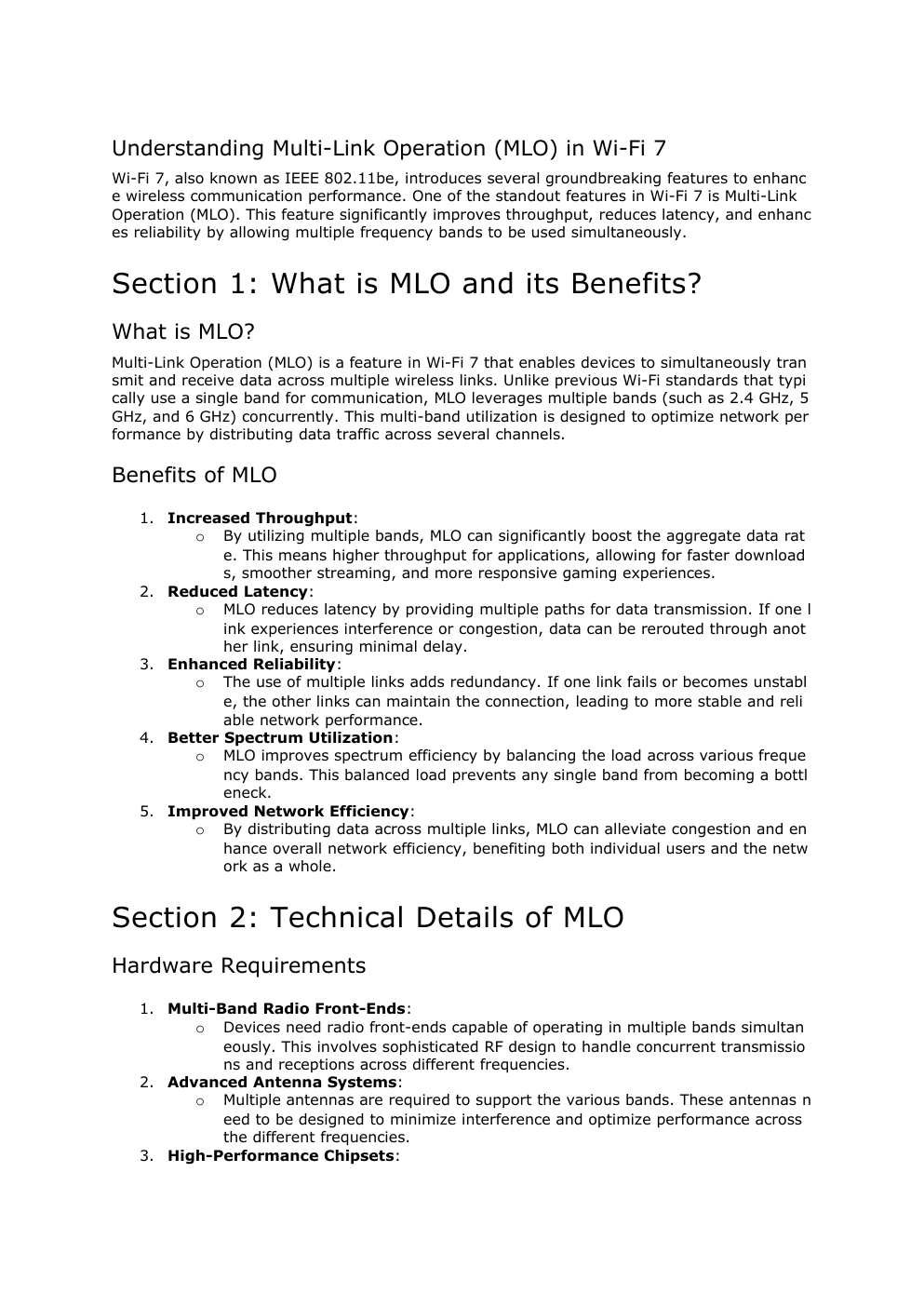Understanding Multi-Link Operation (MLO) in Wi-Fi 7
Publié le 12/06/2024
Extrait du document
«
Understanding Multi-Link Operation (MLO) in Wi-Fi 7
Wi-Fi 7, also known as IEEE 802.11be, introduces several groundbreaking features to enhanc
e wireless communication performance.
One of the standout features in Wi-Fi 7 is Multi-Link
Operation (MLO).
This feature significantly improves throughput, reduces latency, and enhanc
es reliability by allowing multiple frequency bands to be used simultaneously.
Section 1: What is MLO and its Benefits?
What is MLO?
Multi-Link Operation (MLO) is a feature in Wi-Fi 7 that enables devices to simultaneously tran
smit and receive data across multiple wireless links.
Unlike previous Wi-Fi standards that typi
cally use a single band for communication, MLO leverages multiple bands (such as 2.4 GHz, 5
GHz, and 6 GHz) concurrently.
This multi-band utilization is designed to optimize network per
formance by distributing data traffic across several channels.
Benefits of MLO
1.
Increased Throughput:
o By utilizing multiple bands, MLO can significantly boost the aggregate data rat
e.
This means higher throughput for applications, allowing for faster download
s, smoother streaming, and more responsive gaming experiences.
2.
Reduced Latency:
o MLO reduces latency by providing multiple paths for data transmission.
If one l
ink experiences interference or congestion, data can be rerouted through anot
her link, ensuring minimal delay.
3.
Enhanced Reliability:
o The use of multiple links adds redundancy.
If one link fails or becomes unstabl
e, the other links can maintain the connection, leading to more stable and reli
able network performance.
4.
Better Spectrum Utilization:
o MLO improves spectrum efficiency by balancing the load across various freque
ncy bands.
This balanced load prevents any single band from becoming a bottl
eneck.
5.
Improved Network Efficiency:
o By distributing data across multiple links, MLO can alleviate congestion and en
hance overall network efficiency, benefiting both individual users and the netw
ork as a whole.
Section 2: Technical Details of MLO
Hardware Requirements
1.
Multi-Band Radio Front-Ends:
o Devices need radio front-ends capable of operating in multiple bands simultan
eously.
This involves sophisticated RF design to handle concurrent transmissio
ns and receptions across different frequencies.
2.
Advanced Antenna Systems:
o Multiple antennas are required to support the various bands.
These antennas n
eed to be designed to minimize interference and optimize performance across
the different frequencies.
3.
High-Performance Chipsets:
o
The processing power required to manage multiple links simultaneously necess
itates advanced chipsets.
These chipsets must handle complex operations such
as dynamic link selection, load balancing, and interference mitigation.
Software Requirements
1.
Dynamic Link Management:
o Software algorithms are essential for managing the selection and coordination
of multiple links.
These algorithms dynamically select the best links based on f
actors like signal strength, interference, and traffic load.
2.
Load Balancing Mechanisms:
o Efficient load balancing across the links ensures optimal performance.
Softwar
e mechanisms are needed to distribute traffic intelligently, preventing any sing
le link from becoming a bottleneck.
3.
Interference Mitigation:
o MLO requires sophisticated interference mitigation techniques to handle the po
tential for cross-band interference.
This involves both hardware (e.g., filters) a
nd software (e.g., adaptive algorithms) solutions.
4.
QoS Management:
o Quality of Service (QoS) protocols must be enhanced to support MLO, ensurin....
»
↓↓↓ APERÇU DU DOCUMENT ↓↓↓
Liens utiles
- Vixere fortes ante Agamemnona multi
- Solet hora, quod multi anni abstulerunt, reddere
- « Multi-tasking » et « usages et gratifications » ; < l'ère des « télé-sociales ».
- Utilisation of locally delivered doxycycline in non-surgical treatment of chronic periodontitis A comparative multi-centre trial of 2 treatment approaches Jan L.
- Geoffrey Chaucer I INTRODUCTION Geoffrey Chaucer Fourteenth-century English poet and public servant Geoffrey Chaucer wrote verse renowned for its humor, understanding of human character, and innovations in poetic vocabulary and meter.

































